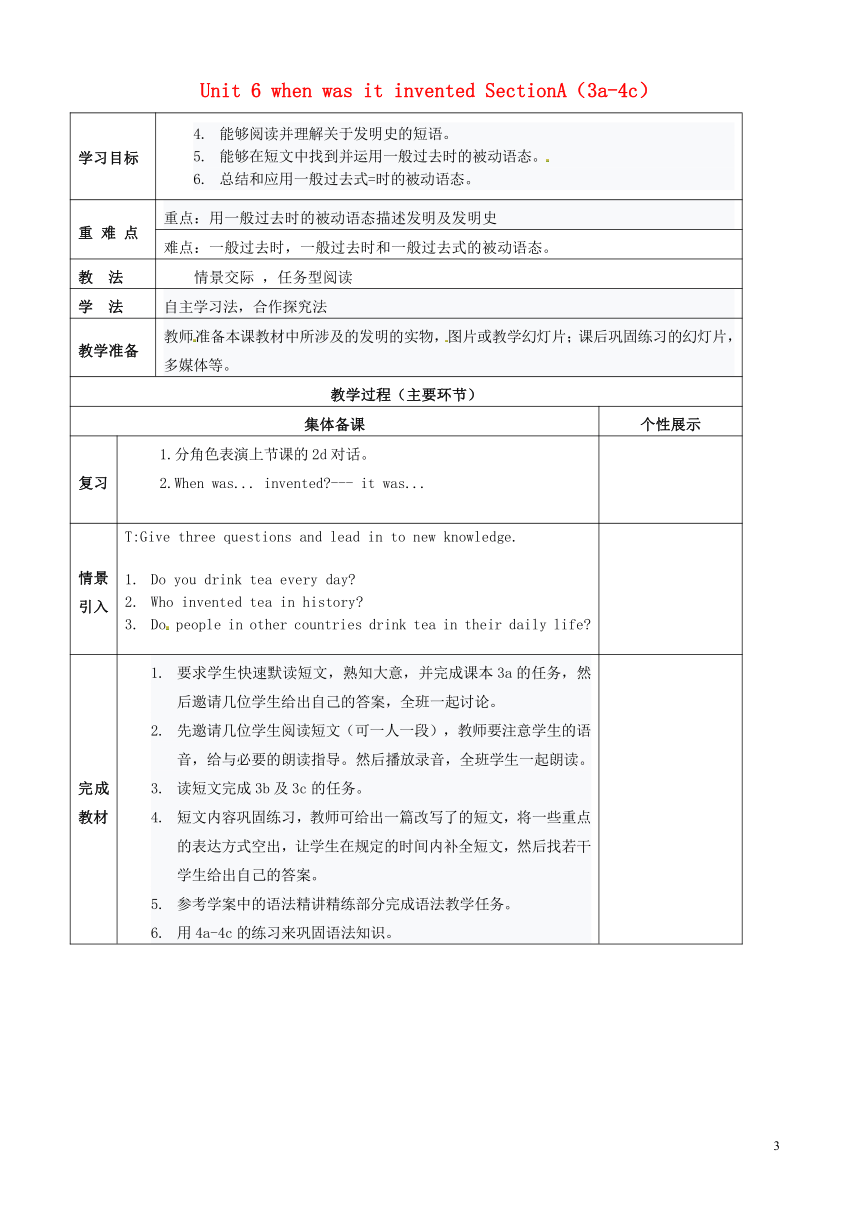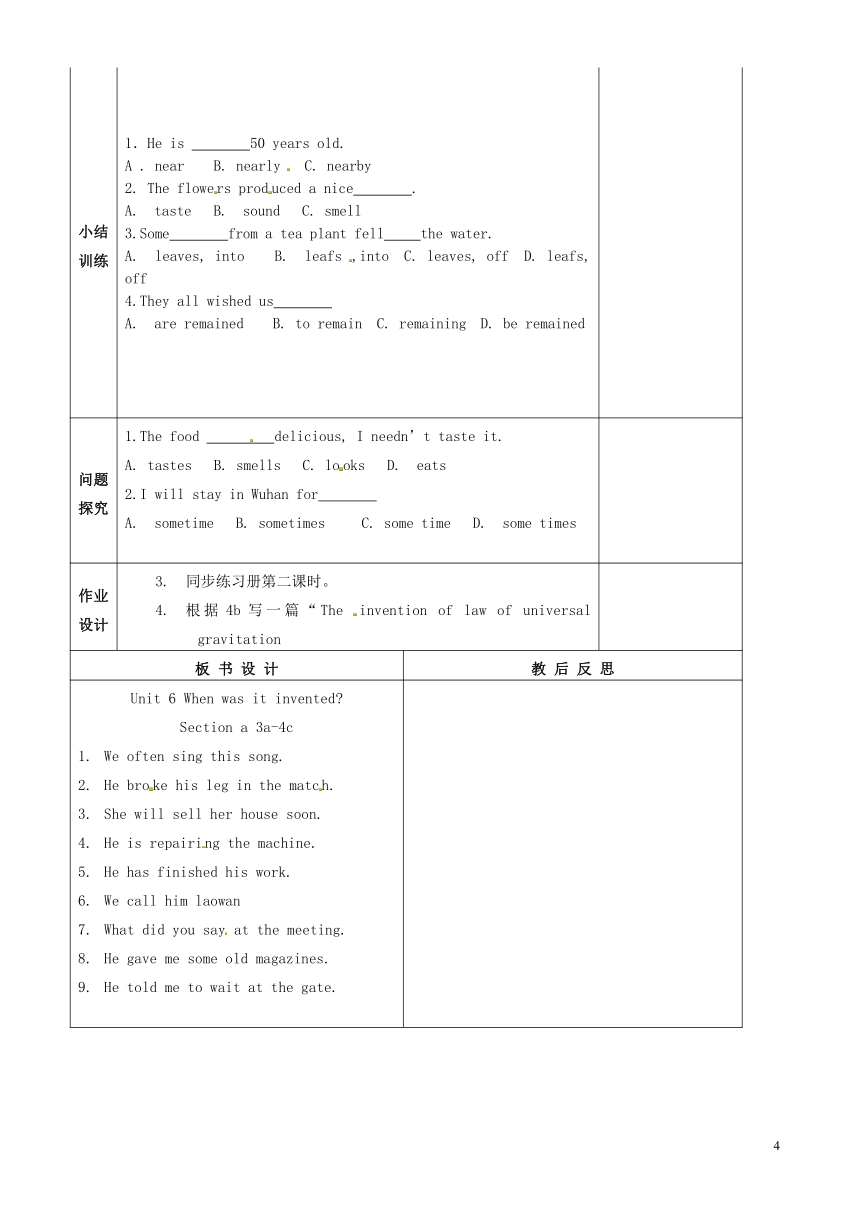重庆市万州区甘宁初级中学九年级英语全册 Unit 6 when was it invented 教案 4课时(新版)人教新目标版
文档属性
| 名称 | 重庆市万州区甘宁初级中学九年级英语全册 Unit 6 when was it invented 教案 4课时(新版)人教新目标版 |  | |
| 格式 | zip | ||
| 文件大小 | 29.6KB | ||
| 资源类型 | 教案 | ||
| 版本资源 | 人教新目标(Go for it)版 | ||
| 科目 | 英语 | ||
| 更新时间 | 2014-12-17 16:11:23 | ||
图片预览




文档简介
Unit 6 when was it invented sectionA(1a-2d)
学习目标 能够用一般过去式的被动语态描述和询问发明史。能够分析归纳一般现在时,一般过去时,和一般过去时的被动语态,并结合实际生活情景理解运用。能够用对比分析的方法掌握一般现在时的被动语态。
重 难 点 重点:一般过去时的被动语态。
难点:一般过去时,一般过去时和一般过去式的被动语态。
教 法 情景交际 ,任务型阅读
学 法 自主学习法,合作探究法
教学准备 教师准备本课教材中所涉及的发明的实物,图片或教学幻灯片;课后巩固练习的幻灯片,多媒体等。
教学过程(主要环节)
集体备课 个性展示
复习 以四人一组形式阅读以“my favorite thing I use every day”为题的短文,每组选出一个最好的,在全班朗读。
情景引入 T:There are many useful things in the world. They help us a lot in life.(show some pictures on the screen)Question :When were they invented Student :The telephone was invented in 1876.The computer was invented in ...
完成教材 阅读1a,完成相应的任务。检查答案,要求全班一起给出答案并检查讨论。要求学生听第二遍录音,并完成课本上1b的听力任务。要求学生听第二遍录音,并逐句进行跟读。完成教材1c的任务,模仿1a的内容,进行对话练习,并邀请2-3名学生当堂进行演示。听第一遍录音,完成2a-2d的任务。听第二遍录音,并逐句进行跟读。大声朗读听力材料。模仿听力内容,利用2a,2d德尔信息分角色进行对话练习。然后邀请2-3名学生当堂演示,看那一对的表现最佳。角色扮演,学生读2d对话,让2-3对学生表演。
小结训练 1.When was the telephone (invent) 2.It (invent)in 1876.3.The shoes with lights are used for seeing in the dark.(对画线部分提问) are the shoes with lights 4.The light bulb(灯泡)was invented by Thomas Edison.(对画线部分提问) the light bulb invented by 5.The refrigerator is used to keep food fresh.(改为同义句)The refrigerator is used food fresh.
问题探究 1.Columbus was American in 1492.A. invented B. discovered C. found D. found out2.A pen is writing.A. used for B. used to C. used by D. used as
作业设计 分角色表演对话2d,有实力的小组可以根据核对话的内容自创其他对话。同步练习册第一课时。
板 书 设 计 教 后 反 思
Unit 6 When was it invented Section a 1a-2dI think the TV was invented before the car.I think the TV was invented after the car
Unit 6 when was it invented SectionA(3a-4c)
学习目标 能够阅读并理解关于发明史的短语。能够在短文中找到并运用一般过去时的被动语态。总结和应用一般过去式=时的被动语态。
重 难 点 重点:用一般过去时的被动语态描述发明及发明史
难点:一般过去时,一般过去时和一般过去式的被动语态。
教 法 情景交际 ,任务型阅读
学 法 自主学习法,合作探究法
教学准备 教师准备本课教材中所涉及的发明的实物,图片或教学幻灯片;课后巩固练习的幻灯片,多媒体等。
教学过程(主要环节)
集体备课 个性展示
复习 1.分角色表演上节课的2d对话。2.When was... invented --- it was...
情景引入 T:Give three questions and lead in to new knowledge.Do you drink tea every day Who invented tea in history Do people in other countries drink tea in their daily life
完成教材 要求学生快速默读短文,熟知大意,并完成课本3a的任务,然后邀请几位学生给出自己的答案,全班一起讨论。先邀请几位学生阅读短文(可一人一段),教师要注意学生的语音,给与必要的朗读指导。然后播放录音,全班学生一起朗读。读短文完成3b及3c的任务。短文内容巩固练习,教师可给出一篇改写了的短文,将一些重点的表达方式空出,让学生在规定的时间内补全短文,然后找若干学生给出自己的答案。参考学案中的语法精讲精练部分完成语法教学任务。用4a-4c的练习来巩固语法知识。
小结训练 1.He is 50 years old.A . near B. nearly C. nearby2. The flowers produced a nice .A. taste B. sound C. smell3.Some from a tea plant fell the water.A. leaves, into B. leafs ,into C. leaves, off D. leafs, off4.They all wished us A. are remained B. to remain C. remaining D. be remained
问题探究 1.The food delicious, I needn’t taste it.A. tastes B. smells C. looks D. eats2.I will stay in Wuhan for A. sometime B. sometimes C. some time D. some times
作业设计 同步练习册第二课时。根据4b写一篇“The invention of law of universal gravitation
板 书 设 计 教 后 反 思
Unit 6 When was it invented Section a 3a-4cWe often sing this song.He broke his leg in the match.She will sell her house soon.He is repairing the machine.He has finished his work.We call him laowanWhat did you say at the meeting.He gave me some old magazines.He told me to wait at the gate.
Unit 6 when was it invented SectionB(1a-2b)
学习目标 能够通过听,说学习与食物和描写食物有关的词汇,并用一般过去时的被动语态表达它们是怎样被发明的。能够用思维导图的方式进行阅读,通过阅读,理解如何用一般过去时的被动语态描述发明史。
重 难 点 重点:学会用一般过去时的被动语态对更广泛的发明进行描述。
难点:一般过去时,一般过去时和一般过去式的被动语态。
教 法 情景交际 ,任务型阅读
学 法 自主学习法,合作探究法
教学准备 教师准备本课教材中所涉及的发明的实物,图片或教学幻灯片;课后巩固练习的幻灯片,多媒体等。
教学过程(主要环节)
集体备课 个性展示
复习 简单复述茶是怎样被发现的。
情景引入 T:some invention have changed our lives. such as telephone, car , computer and so on. they are helpful. but some invention were invented by accident or by mistake. They are also helpful to us. tea was invented by accident. and we will learn the inventions that were invented by mistake.
完成教材 阅读1a的内容,完成相应任务。要求学生完成1b部分的任务,然后找几名学生给出自己答案。并把收集到的答案列举在黑板上。听第一遍录音,完成课本上1c部分的任务。听第二遍录音,完成课文上1d部分的任务。听力内容巩固训练。要求学生根据所听到的内容完成下列对话。完成后要求若干学生给出自己的答案,以巩固对听力内容的理解。听第三遍录音,并打开听力材料,全班逐句进行跟读。放下听力材料,要求学生模仿听力内容,利用1c,1d的信息分角色进行对话练习。然后邀请2-3对学生当堂演示,看那一对的表现最佳。
小结训练 对不起,我刚才错拿了你的字典。Sorry, I took your dictionary just now.2.薯条被炸了很久。The potato chips for a long time.3.它们不够咸。They were not .4.你知道薯条的历史吗?Do you know potato chips
问题探究 那消息使我悲伤。The news me .我终于让那位顾客满意了。I made the happy .
作业设计 同步练习册第三课时。熟读短文,自己尝试着写出短文2d的逻辑线索。
板 书 设 计 教 后 反 思
Unit 6 When was it invented Section B 1a—2bSports countries
Unit 6 when was it invented SectionB(2c-self check)
学习目标 进一步加强对阅读短文2b的理解,并对其中的重点词汇和语言结构进行运用。能够用书面语言写新发明介绍。
重 难 点 重点:用书面语言写新发明。
难点:一般过去时,一般过去时和一般过去式的被动语态。
教 法 情景交际 ,任务型阅读
学 法 自主学习法,合作探究法
教学准备 教师准备本课教材中所涉及的发明的实物,图片或教学幻灯片;课后巩固练习的幻灯片,多媒体等。
教学过程(主要环节)
集体备课 个性展示
复习 检查上课时的课后提升作业。
情景引入 Question :Who like basketball Do you watch basketball games How much do you know about this sport
完成教材 进入短文学习之前,教师要准备几个有助于理解短文内容的问题。要求学生带着问题去阅读短文。在阅读短文后应该能回答所给出的问题。(1)--How old is the sport of basketball ----It’s a little over 100 years old.(2)---Who invented basketball ---A Canadian doctor named Naismith.(3)—When was the first basketball game in history played ---On December 21st,1891.要求学生快速默读短文,熟知大意,并完成课本2d的任务,然后找几位学生给出自己的答案,全班一起讨论检查。完成2e任务。先邀请几位学生阅读短文(可一人一段)教师要注意学生的语音并讲解重点句子,解决学生遇到的疑难问题,然后播放录音,全班学生一起跟读。Writing:让学生说一说自己不喜欢做的事,然后想一个发明来帮助她们做。按照3B中的要求写作,老师巡回指导。教师给出范文,教师点评。
小结训练 1.The boy is trying to (实现)his dream.2.The players (divide)into 3 groups yesterday.3.Some people (仰慕)the great and famous persons.
问题探究 1.A number of the students on the playground now.the number 3000.A.is,is B. is, are C. are, are D. are, is2.The traffic accident stopped me from to the station on time.A. get B. getting C. to get D. got3.He dreamed a snake(蛇)A on B. with C of D in
作业设计 同步练习册第四时。2.Self check 3的提示,以“My favorite invention”为题写一篇新发明的短文。
板 书 设 计 教 后 反 思
Unit 6 When was it invented Section B 2c—self checkWhen ----new invention ---purposeWho
PAGE
6
学习目标 能够用一般过去式的被动语态描述和询问发明史。能够分析归纳一般现在时,一般过去时,和一般过去时的被动语态,并结合实际生活情景理解运用。能够用对比分析的方法掌握一般现在时的被动语态。
重 难 点 重点:一般过去时的被动语态。
难点:一般过去时,一般过去时和一般过去式的被动语态。
教 法 情景交际 ,任务型阅读
学 法 自主学习法,合作探究法
教学准备 教师准备本课教材中所涉及的发明的实物,图片或教学幻灯片;课后巩固练习的幻灯片,多媒体等。
教学过程(主要环节)
集体备课 个性展示
复习 以四人一组形式阅读以“my favorite thing I use every day”为题的短文,每组选出一个最好的,在全班朗读。
情景引入 T:There are many useful things in the world. They help us a lot in life.(show some pictures on the screen)Question :When were they invented Student :The telephone was invented in 1876.The computer was invented in ...
完成教材 阅读1a,完成相应的任务。检查答案,要求全班一起给出答案并检查讨论。要求学生听第二遍录音,并完成课本上1b的听力任务。要求学生听第二遍录音,并逐句进行跟读。完成教材1c的任务,模仿1a的内容,进行对话练习,并邀请2-3名学生当堂进行演示。听第一遍录音,完成2a-2d的任务。听第二遍录音,并逐句进行跟读。大声朗读听力材料。模仿听力内容,利用2a,2d德尔信息分角色进行对话练习。然后邀请2-3名学生当堂演示,看那一对的表现最佳。角色扮演,学生读2d对话,让2-3对学生表演。
小结训练 1.When was the telephone (invent) 2.It (invent)in 1876.3.The shoes with lights are used for seeing in the dark.(对画线部分提问) are the shoes with lights 4.The light bulb(灯泡)was invented by Thomas Edison.(对画线部分提问) the light bulb invented by 5.The refrigerator is used to keep food fresh.(改为同义句)The refrigerator is used food fresh.
问题探究 1.Columbus was American in 1492.A. invented B. discovered C. found D. found out2.A pen is writing.A. used for B. used to C. used by D. used as
作业设计 分角色表演对话2d,有实力的小组可以根据核对话的内容自创其他对话。同步练习册第一课时。
板 书 设 计 教 后 反 思
Unit 6 When was it invented Section a 1a-2dI think the TV was invented before the car.I think the TV was invented after the car
Unit 6 when was it invented SectionA(3a-4c)
学习目标 能够阅读并理解关于发明史的短语。能够在短文中找到并运用一般过去时的被动语态。总结和应用一般过去式=时的被动语态。
重 难 点 重点:用一般过去时的被动语态描述发明及发明史
难点:一般过去时,一般过去时和一般过去式的被动语态。
教 法 情景交际 ,任务型阅读
学 法 自主学习法,合作探究法
教学准备 教师准备本课教材中所涉及的发明的实物,图片或教学幻灯片;课后巩固练习的幻灯片,多媒体等。
教学过程(主要环节)
集体备课 个性展示
复习 1.分角色表演上节课的2d对话。2.When was... invented --- it was...
情景引入 T:Give three questions and lead in to new knowledge.Do you drink tea every day Who invented tea in history Do people in other countries drink tea in their daily life
完成教材 要求学生快速默读短文,熟知大意,并完成课本3a的任务,然后邀请几位学生给出自己的答案,全班一起讨论。先邀请几位学生阅读短文(可一人一段),教师要注意学生的语音,给与必要的朗读指导。然后播放录音,全班学生一起朗读。读短文完成3b及3c的任务。短文内容巩固练习,教师可给出一篇改写了的短文,将一些重点的表达方式空出,让学生在规定的时间内补全短文,然后找若干学生给出自己的答案。参考学案中的语法精讲精练部分完成语法教学任务。用4a-4c的练习来巩固语法知识。
小结训练 1.He is 50 years old.A . near B. nearly C. nearby2. The flowers produced a nice .A. taste B. sound C. smell3.Some from a tea plant fell the water.A. leaves, into B. leafs ,into C. leaves, off D. leafs, off4.They all wished us A. are remained B. to remain C. remaining D. be remained
问题探究 1.The food delicious, I needn’t taste it.A. tastes B. smells C. looks D. eats2.I will stay in Wuhan for A. sometime B. sometimes C. some time D. some times
作业设计 同步练习册第二课时。根据4b写一篇“The invention of law of universal gravitation
板 书 设 计 教 后 反 思
Unit 6 When was it invented Section a 3a-4cWe often sing this song.He broke his leg in the match.She will sell her house soon.He is repairing the machine.He has finished his work.We call him laowanWhat did you say at the meeting.He gave me some old magazines.He told me to wait at the gate.
Unit 6 when was it invented SectionB(1a-2b)
学习目标 能够通过听,说学习与食物和描写食物有关的词汇,并用一般过去时的被动语态表达它们是怎样被发明的。能够用思维导图的方式进行阅读,通过阅读,理解如何用一般过去时的被动语态描述发明史。
重 难 点 重点:学会用一般过去时的被动语态对更广泛的发明进行描述。
难点:一般过去时,一般过去时和一般过去式的被动语态。
教 法 情景交际 ,任务型阅读
学 法 自主学习法,合作探究法
教学准备 教师准备本课教材中所涉及的发明的实物,图片或教学幻灯片;课后巩固练习的幻灯片,多媒体等。
教学过程(主要环节)
集体备课 个性展示
复习 简单复述茶是怎样被发现的。
情景引入 T:some invention have changed our lives. such as telephone, car , computer and so on. they are helpful. but some invention were invented by accident or by mistake. They are also helpful to us. tea was invented by accident. and we will learn the inventions that were invented by mistake.
完成教材 阅读1a的内容,完成相应任务。要求学生完成1b部分的任务,然后找几名学生给出自己答案。并把收集到的答案列举在黑板上。听第一遍录音,完成课本上1c部分的任务。听第二遍录音,完成课文上1d部分的任务。听力内容巩固训练。要求学生根据所听到的内容完成下列对话。完成后要求若干学生给出自己的答案,以巩固对听力内容的理解。听第三遍录音,并打开听力材料,全班逐句进行跟读。放下听力材料,要求学生模仿听力内容,利用1c,1d的信息分角色进行对话练习。然后邀请2-3对学生当堂演示,看那一对的表现最佳。
小结训练 对不起,我刚才错拿了你的字典。Sorry, I took your dictionary just now.2.薯条被炸了很久。The potato chips for a long time.3.它们不够咸。They were not .4.你知道薯条的历史吗?Do you know potato chips
问题探究 那消息使我悲伤。The news me .我终于让那位顾客满意了。I made the happy .
作业设计 同步练习册第三课时。熟读短文,自己尝试着写出短文2d的逻辑线索。
板 书 设 计 教 后 反 思
Unit 6 When was it invented Section B 1a—2bSports countries
Unit 6 when was it invented SectionB(2c-self check)
学习目标 进一步加强对阅读短文2b的理解,并对其中的重点词汇和语言结构进行运用。能够用书面语言写新发明介绍。
重 难 点 重点:用书面语言写新发明。
难点:一般过去时,一般过去时和一般过去式的被动语态。
教 法 情景交际 ,任务型阅读
学 法 自主学习法,合作探究法
教学准备 教师准备本课教材中所涉及的发明的实物,图片或教学幻灯片;课后巩固练习的幻灯片,多媒体等。
教学过程(主要环节)
集体备课 个性展示
复习 检查上课时的课后提升作业。
情景引入 Question :Who like basketball Do you watch basketball games How much do you know about this sport
完成教材 进入短文学习之前,教师要准备几个有助于理解短文内容的问题。要求学生带着问题去阅读短文。在阅读短文后应该能回答所给出的问题。(1)--How old is the sport of basketball ----It’s a little over 100 years old.(2)---Who invented basketball ---A Canadian doctor named Naismith.(3)—When was the first basketball game in history played ---On December 21st,1891.要求学生快速默读短文,熟知大意,并完成课本2d的任务,然后找几位学生给出自己的答案,全班一起讨论检查。完成2e任务。先邀请几位学生阅读短文(可一人一段)教师要注意学生的语音并讲解重点句子,解决学生遇到的疑难问题,然后播放录音,全班学生一起跟读。Writing:让学生说一说自己不喜欢做的事,然后想一个发明来帮助她们做。按照3B中的要求写作,老师巡回指导。教师给出范文,教师点评。
小结训练 1.The boy is trying to (实现)his dream.2.The players (divide)into 3 groups yesterday.3.Some people (仰慕)the great and famous persons.
问题探究 1.A number of the students on the playground now.the number 3000.A.is,is B. is, are C. are, are D. are, is2.The traffic accident stopped me from to the station on time.A. get B. getting C. to get D. got3.He dreamed a snake(蛇)A on B. with C of D in
作业设计 同步练习册第四时。2.Self check 3的提示,以“My favorite invention”为题写一篇新发明的短文。
板 书 设 计 教 后 反 思
Unit 6 When was it invented Section B 2c—self checkWhen ----new invention ---purposeWho
PAGE
6
同课章节目录
- Unit 1 How can we become good learners.
- Section A
- Section B
- Unit 2 I think that mooncakes are delicious!
- Section A
- Section B
- Unit 3 Could you please tell me where the restroom
- Section A
- Section B
- Unit 4 I used to be afraid of the dark.
- Section A
- Section B
- Unit 5 What are the shirts made of?
- Section A
- Section B
- Review of Units 1-5
- Unit 6 When was it invented?
- Section A
- Section B
- Unit 7 Teenagers should be allowed to choose their
- Section A
- Section B
- Unit 8 It must belong to Carla.
- Section A
- Section B
- Unit 9 I like music that I can dance to.
- Section A
- Section B
- Unit 10 You're supposed to shake hands.
- Section A
- Section B
- Review of Units 6-10
- Unit 11 Sad movies make me cry.
- Section A
- Section B
- Unit 12 Life is full of the unexpected
- Section A
- Section B
- Unit 13 We're trying to save the earth!
- Section A
- Section B
- Unit 14 I remember meeting all of you in Grade 7.
- Section A
- Section B
- Review of Units 11-14
